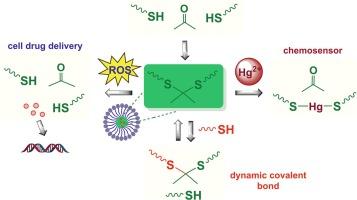聚硫乙醛:从旧化学到新视角
IF 5.8
2区 化学
Q1 POLYMER SCIENCE
引用次数: 0
摘要
在这篇综述中,我们全面介绍了从过去到现在通过阶跃生长、链生长和聚合后改性技术制备聚硫乙醛(PTAs)的合成方法。此外,我们还回顾了 PTAs 作为活性氧(ROS)响应聚合物、Hg2+ 离子化学传感器以及具有动态共价键特性的聚合物的最新应用。由于将 PTAs 广泛应用于细胞输送活性氧 (ROS) 超出了本综述的范围,因此只讨论了一些开创性工作,其余项目仅在文中引用。不过,本文对利用 PTAs 作为 Hg2+ 离子的化学传感器以及 PTAs 的动态共价键特性进行了广泛综述。此外,文中还介绍了质子庇护所和聚合物骨水泥等不太常见的 PTA 应用实例。PTA 的实际可合成性及其在材料科学和生物基应用领域的广泛应用表明,这一基本反应在未来将不断应用于化学的各个学科。本文章由计算机程序翻译,如有差异,请以英文原文为准。

Polythioacetals: From old chemistry to new perspectives
In this review, we comprehensively described the synthetic approaches for the preparation of polythioacetals (PTAs) by step-growth, chain-growth, and post-polymerization modification techniques from the past to the present. In addition, we reviewed the state-of-the-art applications of PTAs as reactive oxygen species (ROS) responsive polymers, chemosensors for Hg2+ ions, and polymers with dynamic covalent bond properties. Since a wide range of reactive oxygen species (ROS) applications of PTAs for cell delivery is beyond the scope of this review, some pioneering works are discussed, and the remaining items are only cited in the text. However, the utilization of PTAs as chemosensors for Hg2+ ions and the dynamic covalent bond properties of PTAs are extensively reviewed here. Also, as less common implementations of PTAs, the proton shelter and the polymeric bone cement examples are described in the text. The practical synthesizability of PTA and its wide range of applications in materials science and bio-based applications indicate that this fundamental reaction will proceed to be used continuously in various disciplines of chemistry in the future.
求助全文
通过发布文献求助,成功后即可免费获取论文全文。
去求助
来源期刊

European Polymer Journal
化学-高分子科学
CiteScore
9.90
自引率
10.00%
发文量
691
审稿时长
23 days
期刊介绍:
European Polymer Journal is dedicated to publishing work on fundamental and applied polymer chemistry and macromolecular materials. The journal covers all aspects of polymer synthesis, including polymerization mechanisms and chemical functional transformations, with a focus on novel polymers and the relationships between molecular structure and polymer properties. In addition, we welcome submissions on bio-based or renewable polymers, stimuli-responsive systems and polymer bio-hybrids. European Polymer Journal also publishes research on the biomedical application of polymers, including drug delivery and regenerative medicine. The main scope is covered but not limited to the following core research areas:
Polymer synthesis and functionalization
• Novel synthetic routes for polymerization, functional modification, controlled/living polymerization and precision polymers.
Stimuli-responsive polymers
• Including shape memory and self-healing polymers.
Supramolecular polymers and self-assembly
• Molecular recognition and higher order polymer structures.
Renewable and sustainable polymers
• Bio-based, biodegradable and anti-microbial polymers and polymeric bio-nanocomposites.
Polymers at interfaces and surfaces
• Chemistry and engineering of surfaces with biological relevance, including patterning, antifouling polymers and polymers for membrane applications.
Biomedical applications and nanomedicine
• Polymers for regenerative medicine, drug delivery molecular release and gene therapy
The scope of European Polymer Journal no longer includes Polymer Physics.
 求助内容:
求助内容: 应助结果提醒方式:
应助结果提醒方式:


